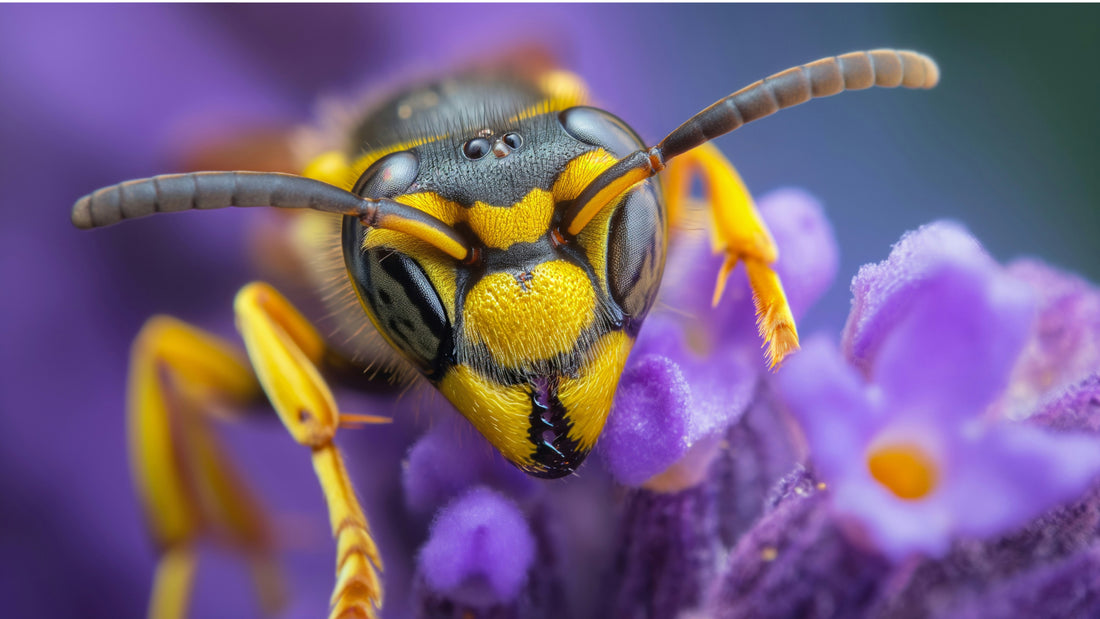Often known as one of nature’s scariest common insects, wasps have a unique way of ruining our outdoor fun. Afraid of their dreaded sting, some people tend to allow wasps to control how much time they spend outside. And when it comes to wasps, yellow jackets, and hornets, it’s not just a summer problem; they’re aggressive during the fall season, too.
Our hope at Wondercide is for everyone to make the most of this wonderful season with apple picking, hay rides, picnics, and more outdoor fun – without the fear of being stung. So, we’re breaking down why wasps and other stinging insects are so active during the fall and how to avoid them.
Why are wasps so aggressive during the fall?
The wasp population grows the most in the late summer and early fall, right around the time the weather begins to cool. Unlike many other insects, wasps are adapted to the colder weather. As the temperature drops, the wasps’ food supply – including honey, honeydew, nectar, fruit, spiders, and small insects – becomes scarce. So, the wasps starve. This causes the flying predators to become angry and defensive over their food supply and nests, which is why they are so aggressive during this time. So the ecosystem isn’t working in their favor in the fall.
An angry wasp will likely attack a honeybee hive to find food. They are often successful due to honey bees’ naturally slower and more docile behavior during the fall. Sadly for honey bees, wasps have been known to take over entire hives and don’t show any mercy.
After the fall season ends, the wasp colony will die out, leaving only the queen behind. The queen will hibernate underground during the winter and then begin a new colony in the spring. However, in extremely cold temperatures, the queen may not survive the harsh winter, preventing the establishment of a new colony.
During the spring, wasps have complete access to food and are generally less populated than in the fall. So, the only time you might find yourself in a tussle with its stinger is if you accidentally threaten the wasp or get in its way. The only exception to this rule is the yellow jacket, which tends to be on the offense more than other types of wasps.
How to tell the difference between wasps, yellow jackets, hornets, and bumble bees.
We understand the fear of spotting a yellow streak zooming through the air, accompanied by that dreaded buzzing sound. But how do you know which insect you’re looking at? There are certain subtle distinctions and some major differences between various types of wasps and bees, and we're here to help you understand them!
Wasps: These pesky stingers are most distinguishable by their dangling legs and pointed abdomen. Wasps are omnivorous, unlike bees. They feed off insects in addition to natural sugars such as honey and nectar. Wasps can sting more than once, but will most likely only use their weapons when they feel like they're in danger or provoked by threatening activity.
Hornets: A hornet is physically distinguished from other kinds of wasps with their fatter shape and larger size. The top species in the U.S. has a reddish head. It’s important to be on the lookout for hornets when spending time outside because their sting is quite painful. But unlike yellow jackets, a hornet will likely only attack when it feels threatened.
Yellow Jackets: Like their name, a yellow jacket is covered in black and yellow stripes. These colorful wasps are thin-waisted with a smooth exterior and tend to build their nests underground, but occasionally reside in trees or buildings. These fierce stingers consume a high-protein diet, seeking insects to eat, both dead and alive.
The reason yellow jackets are amongst the most troublesome flying insects is because they have the ability to sting more than once like other wasps and have been known to attack unprovoked. This makes them unpredictable and more difficult to avoid.
Bumblebees: Different from honeybees, which are a yellow-orange color, these pollinators are black and yellow, like a larger, hairier wasp.
A bee is a much smaller threat than a wasp, yellow jacket, or hornet. These fuzzy, flying vegetarians are often docile and will only sting if they feel that their nest is being threatened. A bee sting may hurt, but it will most likely take the bee’s life, which is why they are less inclined to strike. Bees have a barb on their stingers, which comes off once the stinger hits flesh, causing the bee to lose its ability to sting a second time.
All bees are pollinators, which is made possible by their hairy bodies that catch the pollen and allow them to transport it as they buzz from flower to flower. When a bee pollinates a flower, it also transports some back to its nest to create something called “bee bread”. Bee bread is a sugary substance that provides the bees with a great source of protein.
For more on how to distinguish bees, including honey bees, from wasps, hornet, and yellow jackets, read this e-magazine article.
How to avoid them.
Now that you can identify these flying stingers, how do you avoid them altogether? First, it’s important to acknowledge that while they may cause people distress in the case of severe allergies, bees are actually very beneficial to the ecosystem and should be left alone if possible. Their strong role as pollinators plays a significant part in the food that humans consume.
But let’s take care of the wasp situation, shall we? Wondercide’s Wasp & Hornet Spray for porch and patio will help you quickly conquer these unwanted pests. This plant-powered aeroool kills hornets, wasps, and yellow jackets, and works on open-faced hives. Wasp & Hornet spray is proven to meet the effectiveness requirements of conventional pest control, without the conventional ingredients. This means that you’ll be able to keep your family safe when you use it as directed.
Once the little stinger has landed on a surface, simply spray the insect from approximately 18 inches away for about one second to completely coat the wasp. After the wasp dies, be sure to clean it up with a cloth or towel. The sprayer has a 15-foot long range nozzle so you can stay safely away from the stingers.
What to do if you have a hive.
If you find a small cluster of honeycomb and holes, you’ve likely stumbled upon a wasp nest. The first thing to do when you find a hive around your home is to remain calm. We promise you won’t have to accept a colony of wasps as your new neighbors. Simply run back inside to grab your Wasp & Hornet Spray. Spray the hive from a good distance away until it’s completely covered. The wasps will die by contact and then you’re safe to remove the hive from its location. It’s best to spray after dusk so the wasp activity is minimal, and make sure that no one is standing below the hive during the spraying process.
Some nests are found on porches or in trees, while some yellow jacket nests are found in the ground. If you stumble across a closed nest, which is likely a hornet or yellow jacket nest, or one that is hidden in an attic or wall, it’s best to call a professional to come and remove it for you. Try not to plug the nest opening because that will force the colony of wasps to further chew their way into your home.
Now that you’re a wasp and bee expert, we hope you’ll have an easier time this fall as you navigate the insect situation. Don’t let the wasps win! Equipped with your newfound knowledge, you can approach these buzzing visitors with more confidence and the power to show them who’s boss. Whether you're hiking, picnicking, or simply enjoying your backyard, you will come out victorious against these stinging pests. Together, we will embrace a season of outdoor fall adventures, unscathed by pests, and make the most of this magical time of year.





